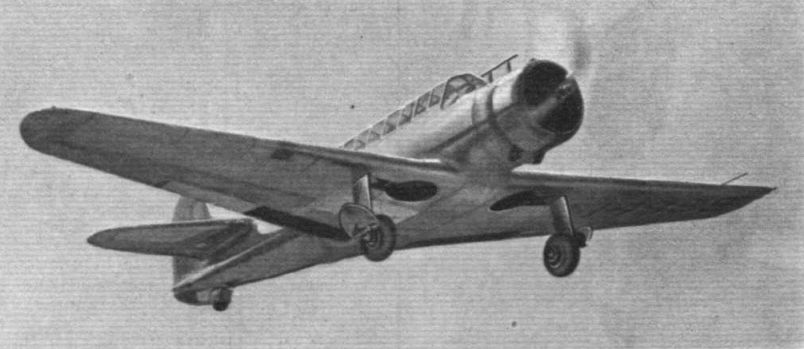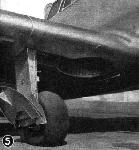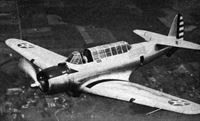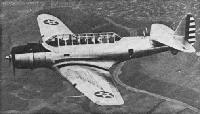
Варианты
- Vultee - V-11 - 1935 - США
- Vultee - V-12 - 1939 - США
Vultee V-11 и V-12
Прототип штурмовика Vultee V-11 выполнил первый полет в 1935 году, но вскоре разбился. Самолет спроектирован на основе V-1A с новым горизонтальным оперением и фюзеляжем эллиптического сечения. Экипаж из двух человек разместили тандемом в закрытой длинным прозрачным фонарем кабине.
Вслед за V-11 вскоре построили прототип V-11G, главным отличием которого являлся мотор SGR-1820-G2 Cyclone мощностью 1000 л.с. (746 кВт). Потенциальным заказчикам предложили и трехместный прототип V-11GB. Китай заказал 30 V-11G, которые принимали участие в боях с японцами.
СССР закупил один самолет V-11GB с расчетом наладить выпуск самолетов по лицензии под обозначением БШ. Всего построили 31 самолет. Летные данные БШ сильно упали из-за установки советского мотора М-62 мощностью 920 л,с. и брони. Штурмовики переделали в почтовые ПС-43, эти самолеты использовались для перевозки грузов на протяжении всей Великой Отечественной войны.
Турция заказала 40 самолетов V-11GB, ими в 1937 году вооружили 2-й полк турецких ВВС. Наконец 18 V-11GB и восемь машин в варианте торпедоносца-бомбардировщика с поплавковым шасси закупила Бразилия.
Под впечатлением экспортных поставок авиационный корпус Армии США закупил для оценочных испытаний семь V-11GB под обозначением YA-19. Затем самолеты доработали под испытания двигателей. На XA-19A испытывался экспериментальный мотор Avco Lycoming O-1230-1 мощностью 1275 л.с., а на XA-19B - Pratt & Whitney R-2800-1 Double Wasp мощностью 1800 л. с.
<...>
ТАКТИКО-ТЕХНИЧЕСКИЕ ХАРАКТЕРИСТИКИ
Vultee V-11GB
Тип: трехместный штурмовик
Силовая установка: один мотор воздушного охлаждения Wright SGR-1820-G2 Cyclone мощностью 1000 л. с. (746 кВт)
Летные характеристики: макс. скорость 369 км/ч; практический потолок 7010 м; дальность 1971 км
Масса: пустого снаряженного 2801 кг; максимальная взлетная 5188 кг
Размеры: размах крыла 15,24 м; длина 11,42 м; высота 3,05 м; площадь крыла 35,67 м2
Вооружение: шесть 7,62-мм пулеметов, до 272 кг бомб во внутреннем отсеке
Описание:
- Vultee V-11 и V-12
- Flight, October 1935
A MILITARY VULTEE - Flight, January 1936
SOME NEW AMERICANS
Фотографии
-
Авиация и Время 2005-04 / В.Котельников - Как "Валти" превратился в ПС-43
Vultee V-11G ВВС Китая. Втрая половина 1930-х гг.
-
Авиация и Время 2005-04 / В.Котельников - Как "Валти" превратился в ПС-43
Vultee V-11G ВВС Бразилии, 1940г.
-
АвиаМастер 2004-01 / В.Котельников - Почтовый штурмовик: самолет БШ-1 /Монография/
"Валти" V-11G (самолет-эталон N 32) на испытаниях в СССР, 1937г.
-
Авиация и Время 2005-04 / В.Котельников - Как "Валти" превратился в ПС-43
Vultee V-11G на Государственных испытаниях в СССР, 1937г.
-
АвиаМастер 2004-01 / В.Котельников - Почтовый штурмовик: самолет БШ-1 /Монография/
Головной серийный экземпляр БШ-1 на испытаниях в НИИ ВВС, 1939г.
-
Авиация и Время 2005-04 / В.Котельников - Как "Валти" превратился в ПС-43
Серийный БШ-1. Госиспытания, январь 1939г.
-
АвиаМастер 2004-01 / В.Котельников - Почтовый штурмовик: самолет БШ-1 /Монография/
Регистрационный номер: СССР-Л3016 [3] Почтово-пассажирский ПС-43 на службе "Аэрофлота", 1941г.
-
Авиация и Время 2005-04 / В.Котельников - Как "Валти" превратился в ПС-43
Регистрационный номер: СССР-Л3016 [3] ПС-43 на испытаниях в НИИ ГВФ в 1939г.
-
Air Enthusiast 1971-07 / ??? - A pictorial history of Turkish Military Aviation
Vultee V-11-GB of the 2nd Regiment, Diyarbakir, 1939.
-
Flight 1935-10 / Flight
Like its civil predecessor, the new Vultee has an inwardly retracting undercarriage. This view shows the "German" tail unit to advantage.
-
Авиация и Время 2005-04 / В.Котельников - Как "Валти" превратился в ПС-43
Опытный экземпляр самолета Валти V-11
-
Flight 1936-01 / Flight
The long "conservatory" is the most striking feature of the machine.
-
Air Enthusiast 1972-07 / ??? - Those versatile Vultees
Регистрационный номер: NR14980 The prototype of the V-11-G attack bomber (NR14980).
-
Flight 1940-03 / Flight
It is shown how a single large bomb can be carried externally.
-
Мировая Авиация 250
V-11GB был близок к варианту V-11G, но отличался наличием нижней люковой оборонительной пулеметной установки.
LOW-FLYER: The latest version of the Vultee attack-bomber, which is suitable for ground strafing. Note the empennage and lower gun. Orders have been placed by China, Russia and European and South American Governments. -
Jane's All the World Aircraft 1938 / 03 - All the world's aeroplanes
The Vultee V-11-GB Three-seat Attack-Bomber Monoplane (900 h.p. Wright "Cyclone" engine).
-
Авиация и Космонавтика 2019-02 / О.Растренин - Американский "Иванов" или "Валти" по-советски
Государственные испытания американского самолета Валти V-11GB зав. N 33 в НИИ ВВС летом 1937г.
-
Авиация и Космонавтика 2019-02 / О.Растренин - Американский "Иванов" или "Валти" по-советски
Самолет Валти V-11GB зав. №33 с подвеской двух бомб ФАБ-250 и одной бомбы ФАБ-50 под центропланом
-
АвиаМастер 2004-01 / В.Котельников - Почтовый штурмовик: самолет БШ-1 /Монография/
Головной серийный экземпляр БШ-1 на испытаниях в НИИ ВВС, 1938г. Обратите внимание на мачту антенны и лобовые жалюзи капота, отсутствовавшие у американского прототипа этой машины, а также на то, что стволы крыльевых пулеметов заменены обтекаемыми макетами.
-
АвиаМастер 2004-01 / В.Котельников - Почтовый штурмовик: самолет БШ-1 /Монография/
Головной экземпляр БШ-1 на испытаниях в НИИ ВВС, вид 3/4 сзади.
-
Авиация и Космонавтика 2019-02 / О.Растренин - Американский "Иванов" или "Валти" по-советски
БШ-1м с подвешенными под центропланом и консолями бомбами ФАБ-50
-
Авиация и Космонавтика 2019-02 / О.Растренин - Американский "Иванов" или "Валти" по-советски
Подвеска под центропланом БШ-1м бомб ФАБ-50-100 и подвеска под консолью крыла бомбы ФАБ-100
-
Авиация и Космонавтика 2019-02 / О.Растренин - Американский "Иванов" или "Валти" по-советски
БШ-1м с подвешенными под центропланом и консолями бомбами ФАБ-50
-
Авиация и Космонавтика 2019-02 / О.Растренин - Американский "Иванов" или "Валти" по-советски
БШ-1м с подвешенными под центропланом дымовыми авиаприборами ДАП-100 и выливными авиаприборами ВАП-4 под консолями
-
Flight 1936-01 / Flight
A Wright Cyclone of 750 h.p. is fitted to the new Vultee V-11 attack bomber. In this view the cowling has been removed and the exhaust system and several other items are visible.
-
АвиаМастер 2004-01 / В.Котельников - Почтовый штурмовик: самолет БШ-1 /Монография/
Головной экземпляр БШ-1: испытания в зимних условиях на неубирающемся лыжном шасси, 1939г.
-
АвиаМастер 2004-01 / В.Котельников - Почтовый штурмовик: самолет БШ-1 /Монография/
БШ-1 на службе "Аэрофлота". Вооружение и лобовые жалюзи капота на данном самолете не установлены.
-
Air Enthusiast 1971-07 / Plane facts
The only known photograph of the one of the Soviet-built examples of the V-11-GB in Aeroflot service as a PS-43 mailplane. This type was operated over the Moscow-Kiev-Tashkent route.
-
АвиаМастер 2004-01 / В.Котельников - Почтовый штурмовик: самолет БШ-1 /Монография/
Регистрационный номер: СССР-Л3016 [3] Рейсовый ПС-43 (БШ-1) в полете.
-
Авиация и Время 2005-04 / В.Котельников - Как "Валти" превратился в ПС-43
Хвостовое оперение V-11G
-
Авиация и Космонавтика 2019-02 / О.Растренин - Американский "Иванов" или "Валти" по-советски
Турель МВ-3 с пулеметом ШКАС
-
Авиация и Время 2005-04 / В.Котельников - Как "Валти" превратился в ПС-43
Мотор Райт GR-1820-G2 на V-11G
-
АвиаМастер 2004-01 / В.Котельников - Почтовый штурмовик: самолет БШ-1 /Монография/
Раскапотированная силовая установка БШ-1
-
АвиаМастер 2004-01 / В.Котельников - Почтовый штурмовик: самолет БШ-1 /Монография/
Раскапотированный мотор М-62ИР с винтом ВИШ-2ПА на БШ-1
-
Авиация и Космонавтика 2019-02 / О.Растренин - Американский "Иванов" или "Валти" по-советски
Крыльевая установка пулеметов Браунинг
-
Авиация и Космонавтика 2019-02 / О.Растренин - Американский "Иванов" или "Валти" по-советски
Установка пулеметов ШКАС в крыле БШ-1м
-
Авиация и Космонавтика 2019-02 / О.Растренин - Американский "Иванов" или "Валти" по-советски
Подвеска на кассетном держателе КД-1-10 образца 1938 г. осколочных бомб АО-8мб
-
Авиация и Космонавтика 2019-02 / О.Растренин - Американский "Иванов" или "Валти" по-советски
Подвеска на кассетном держателе КД-1-10 образца 1938 г. осколочных бомб АО-20м2
-
Авиация и Время 2005-04 / В.Котельников - Как "Валти" превратился в ПС-43
Кассета КД-1-8 с бомбами ЗАБ-10ТГ
-
Flight 1936-01 / Flight
A sturdy inwardly-retracting undercarriage is not the least interesting feature. Shock absorption is obtained by means of oleo legs, rubber taxying pads and air wheels.
-
Flight 1936-01 / Flight
Details of the wing structure and the operating mechanism for one-half of the undercarriage. Retraction is effected either manually or electrically by a system of torque shafts and bevel gears driving a worm and gear quadrant mechanism attached to the upper end of each undercarriage strut.
-
Flight 1936-01 / Flight
The tail cone and fin structure is a unit removable from the fuselage
-
Авиация и Космонавтика 1999-01 / В.Ильин - Авиация великого соседа (1)
Легкие бомбардировщика Валти V-11 и Нортроп 2E китайских ВВС
Другие самолёты на фотографии: Northrop Gamma / A-13 / A-16 - США - 1932
-
Авиация и Время 2005-04 / В.Котельников - Как "Валти" превратился в ПС-43
V-11GB на вооружении ВВС Бразилии
-
Air Enthusiast 1972-07 / ??? - Those versatile Vultees
A V-11-GB attack bomber of the Brazilian Army Air Service.
-
Авиация и Время 2002-06 / А.Харук - ВВС Бразилии во второй мировой войне (1)
До поступления специальных самолетов бразильцы использовали для борьбы с подводными лодками легкие бомбардировщики "Валти" V11GB (на фото), многоцелевые "Корсары" и FW 58
-
Air Enthusiast 1972-11 / Talkback
One of the eight Lockheed 12As operated by the Brazilian Army Aviation Service. Photograph of it (c/n 1235) taken on 18 November 1939 at Afonsos airfield, Rio, against an interesting background of (left to right) a Vought V.65B Corsair, a Bellanca 31-42 Pacemaker, a Waco EGC-7 and two Vultee V-11GB2s.
Другие самолёты на фотографии: Bellanca Pacemaker / Skyrocket - США - 1928Lockheed Electra Junior 12 - США - 1936Vought O2U/O3U/V-65/V-93 Corsair - США - 1926WACO C / S Series - США - 1931
-
Air Enthusiast 1972-07 / ??? - Those versatile Vultees
One of the eight examples of this aircraft fitted with twin Edo floats and delivered to Brazil for operation as torpedo-bomber.
-
Flight 1939-09 / Flight
The new 1,600 h.p. Pratt and Whitney Double Wasp installed in a Vultee YA-19 bomber. As this particular engine is without the extension shaft, the spinner is not needed.
-
Air Enthusiast 1972-07 / ??? - Those versatile Vultees
One of the YA-19s delivered to the US Army Air Corps for evaluation.
-
Air Enthusiast 1972-12 / Talkback
The Vultee YA-19 in service with the HQ Squadron, 17th Attack Group, at March Field in September 1939.
-
Air Pictorial 1955-10 / Photos by request
VULTEE XA-19A. Out of the five Vultee YA-19 (Pratt & Whitney Twin Wasp R-1830-17 radials) three-seat attack bombers delivered to the U.S.A.A.F. in 1939, three underwent engine changes to become the XA-19A (Lycoming); XA-19B (P. & W. Double Wasp R-2800-I) and XA-19C (P. & W. Twin Wasp R-1830-51). The most interesting conversion was that of the XA-19A which served as a flying test bed for the special twelve-cylinder, liquid-cooled Lycoming XO-1230-1 - the highest-rated horizontally-opposed in-line of World War II, with 1,200 h.p. for take-off. To compensate for the increased side area and fuselage length (increased by 5 in. to 38 ft. 3 in.) the characteristic Gerald Vultee fin was altered to give more area. Despite the improved frontal area streamlining, the experimental Lycoming XA-19A improved the maximum speed by only 2 m.p.h. - to 232 m.p.h. Span was 50 ft. The A-19 was developed from the Vultee Model V-11GB.
-
Air Enthusiast 1972-12 / Talkback
The seventh YA-19 after conversion to XA-19A with Lycoming O-1230 engine.
-
Air Enthusiast 1972-12 / Talkback
The XA-19A subsequently became the XA-19C, as shown here, with Pratt & Whitney R-1830 engine replacing the Lycoming.
-
Air Enthusiast 1972-12 / Talkback
The second YA-19 was assigned to Pratt & Whitney as a test-bed for the R-2800 engine, becoming the XA-19B.
-
Air Pictorial 1956-07 / Photos by request
Регистрационный номер: NX14980 VULTEE F.T.B. (P. & W.). - Something of a "mystery ship" is NX-14980 which has the tail assembly of the well-known three-seat Vultee V-11-GB - mainly built as an export attack-bomber - but little else to identify it. The fixed undercarriage is even more functional than that of the Folland F.T.B. The enclosed single-seat cockpit is almost hidden by the wing. The engine is a Pratt & Whitney 2-row radial. Note the ventral D/F loop and aerial mast.
-
Авиация и Время 2005-04 / В.Котельников - Как "Валти" превратился в ПС-43
Приборная доска V-11G
-
АвиаМастер 2004-01 / В.Котельников - Почтовый штурмовик: самолет БШ-1 /Монография/
Ручка управления и приборное оборудование кабины пилота БШ-1.
-
Авиация и Космонавтика 2019-02 / О.Растренин - Американский "Иванов" или "Валти" по-советски
Кабина летчика БШ-1м. На ручке управления самолетом видны гашетки управления огнем из пулеметов: справа - электрокнопка крайних пулеметов (на них устанавливались электроспуски), слева - гашетка для внутренних пулеметов (на них устанавливались механические спуски). Приборная доска еще американская
-
Flight 1935-10 / Flight
This sketch of the roomy pilot's cockpit of the Vultee attack-bomber shows that, despite the profusion of "gadgets," an orderly layout has been attained.
-
Flight 1936-01 / Flight
The gunner occupies the rear portion of the long cockpit enclosure. This view shows the mounting for his Browning gun.
-
Авиация и Космонавтика 2019-02 / О.Растренин - Американский "Иванов" или "Валти" по-советски
Шкворневая установка в кабине летнаба под пулемет Браунинг
-
Авиация и Космонавтика 2019-02 / О.Растренин - Американский "Иванов" или "Валти" по-советски
Люковая установка ЛУМВ под пулемет ШКАС - снаружи и изнутри
-
Авиация и Космонавтика 2019-02 / О.Растренин - Американский "Иванов" или "Валти" по-советски
Прицел ОПБ-1 в полу кабины штурмана самолета БШ-1 № 32. Также видны механический бомбосбрасыватель АСБР (справа) и электробомбосбрасыватель ЭСБР-2 (слева)
-
Авиация и Космонавтика 2000-11 / А.Демин - Авиация великого соседа (Советские истребители в небе Китая. 1937 - начало 1940-х годов) (10)
Китайский Вэлти V-11, рухнувший на город
-
Авиация и Время 2010-06 / А.Демин - Воздушные драконы Поднебесной (11)
Бомбардировщик "Валти" V-11-G из состава ВВС Китая, совершивший вынужденную посадку. Предположительно лето 1938 г.
-
Авиация и Время 2005-04 / В.Котельников - Как "Валти" превратился в ПС-43
ПС-43, разбитый в результате столкновения с МиГ-3 28 февраля 1941г. Сзади виден ТБ-3, протараненный тем же МиГ-3. Центральный аэродром, Москва
Другие самолёты на фотографии: Туполев ТБ-3Р - Россия - 1932
-
Flight 1940-03 / Flight
A thoroughly sectioned view of the Vultee V-11, which can be used for bombing or ground attack.
- Фотографии








































































